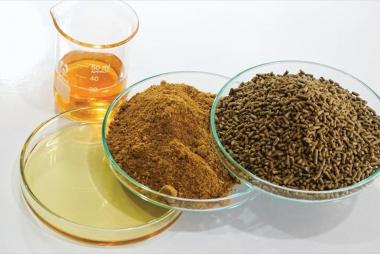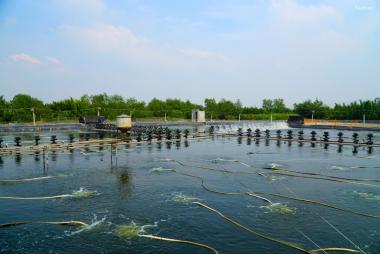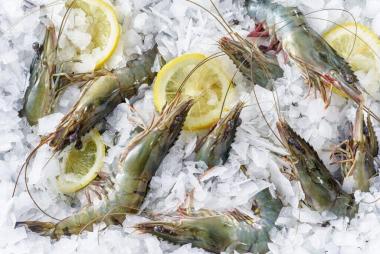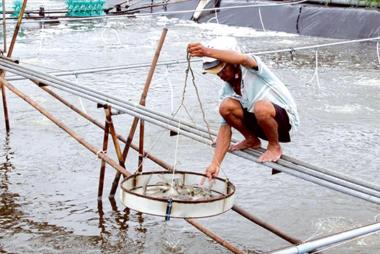- Address: Lot No. 20, Zone G, D1 Street, An Ha Industrial Park, Tan Vinh Loc Commune, Ho Chi Minh City
- Phone: (84-28) 668.36156 / 668.36158
- Hotline: 1800.9435
- Fax: (84-28) 3620.4694
- Email: vibo@vibo.com.vn
- Website https://vibo.com.vn/

Disease caused by DIV1 in shrimp
Disease caused by DIV1 in shrimp
DIV1 (Decapod iridescent virus 1) can cause mass death in shrimp with a high rate of infection. The disease results in quick lethality within just two to three days from the first infection until all shrimp in the pond die. DIV1 can infect small and large shrimp as well as white leg shrimp and giant freshwater prawn.
DIV1 has infected about a quarter of shrimp farms in Guangdong Province (China).
The first symptoms of DIV1 infection in shrimp are Lethargic swimming, reduced appetite, empty stomach and intestines, softshell, reddish body color, broken antenna. Shrimp head also has white to pale yellow color due to pale hepatopancreas. Later on, infected shrimp sink to the bottom of the pond while there is a sudden high mortality rate.

Figure: Clinical symptoms of giant freshwater prawn naturally infected with DIV1. (A) The overall appearance of an infected shrimp in water. (B) The blue arrow shows a white, pale area at the base of the rostrum. The white arrow indicates pale and yellow atrophic hepatopancreas.
DIV1 infection occurs in the cold season and subsides during summer/fall months when temperatures are higher. Temperatures above 30 degrees Celsius will prevent the virus.
Because there is no effective way to prevent the spread of this disease, many shrimp farmers in Guangdong Province (China) do not allow outsiders, including friends and family, to come near shrimp ponds. They believe that in addition to water and the environment, humans can be the source of pathogens for shrimp ponds.
When ponds are infected by DIV1, shrimp must be discarded. Disinfect pathogens and dry ponds for at least two months. Usually, one shrimp pond can grow about four groups of shrimp a year. Therefore, if one shrimp is infected with the virus, the pond's annual production will be reduced by at least a quarter.
DIV1 was first detected in early 2014. In December 2014, scientists from the Chinese Academy of Fishery Sciences first identified the virus in Pacific white leg shrimp, the main species grown in Zhejiang province (China). In 2018, the virus was found in shrimp farms in 11 provinces. In early 2019 and in February 2020, the virus continued to appear in China.
The cause of DIV1 and its transmission is unknown. There are very little scientific information and research about this virus.
Disease caused by DIV1 in shrimp can spread quickly without proper attention. Therefore, it is necessary to strictly implement disease prevention activities before and during each crop.
* Summary of information from South China Morning Post (China), National Center for Biotechnology Information (U.S), Department of Agriculture, Water and the Environment (Australia), and Global Aquaculture Alliance
* Photo by Liang Qiu, Xing Chen, Ruo-Heng Zhao, Chen Li, Wen Gao, Qing-Li Zhang, Jie Huang (2019).
References:
Department of Agriculture, Water and the Environment. (2019). Infection with shrimp haemocyte iridescent virus (SHIV). Retrieved from https://www.agriculture.gov.au/sites/default/files/documents/infection_with_shrimp_haemocyte_iridescent_virus.pdf
Huifeng, H. (2020). China’s shrimp farmers ‘terrified’ as deadly virus threatens to destroy lucrative seafood industry. Retrieved from https://www.scmp.com/economy/china-economy/article/3079484/chinas-shrimp-farmers-terrified-deadly-virus-threatens
Qiu, L., Chen, X., Zhao, R., Li, C., Gao, W., Zhang, Q., & Huang, J. (2019). Description of a Natural Infection with Decapod Iridescent Virus 1 in Farmed Giant Freshwater Prawn, Macrobrachium rosenbergii. Retrieved from https://www.ncbi.nlm.nih.gov/pmc/articles/PMC6521035/
Qiu, L., Chen, X., Zhao, R., Li, C., Gao, W., Zhang, Q., & Huang, J. (2020). First report and description of Decapod Iridescent Virus-1 in giant freshwater prawns. Global Aquaculture Alliance. Retrieved from https://www.aquaculturealliance.org/advocate/first-report-and-description-of-decapod-iridescent-virus-1-in-giant-freshwater-prawns/














